Arvada, CO Pollen and Allergy Report for Summer 2023
Pollen Allergy Trends in Arvada, CO
When is pollen lowest in Arvada, CO?

February
Lowest month total PPM
Avg. PPM
When is pollen highest in Arvada, CO?

March
Highest month total PPM
Avg. PPM
How does pollen in Arvada, CO compare to Colorado?
Arvada has a higher average PPM than the state of Colorado.
Arvada yearly avg PPM:
Colorado yearly avg PPM:
How does pollen in Arvada, CO compare to the USA?
Arvada has a lower average PPM than the USA.
Arvada yearly avg PPM:
USA yearly avg PPM:
Is pollen worse this year in Arvada, CO?
Spring 2023 was worse than spring 2022.
Spring 2023 PPM:
Spring 2022 PPM:
Average PPM in Arvada, CO


Arvada, CO Pollen and Allergy Breakdown by Month
Grass
When is grass pollen highest in Arvada, CO?
April has the highest grass pollen in Arvada, CO with an average PPM of
When is grass pollen lowest in Arvada, CO?
December has the lowest grass pollen in Arvada, CO with an average PPM of
Tree
When is tree pollen highest in Arvada, CO?
March has the highest tree pollen in Arvada, CO with an average PPM of
When is tree pollen lowest in Arvada, CO?
September has the lowest tree pollen in Arvada, CO with an average PPM of
Weed
When is weed pollen highest in Arvada, CO?
November has the highest weed pollen in Arvada, CO with an average PPM of
When is weed pollen lowest in Arvada, CO?
February has the lowest weed pollen in Arvada, CO with an average PPM of
Arvada, CO Pollen Monthly Breakdown by Pollen Type
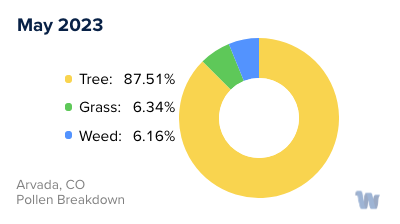

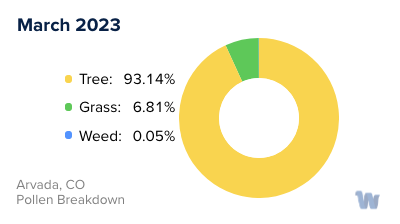

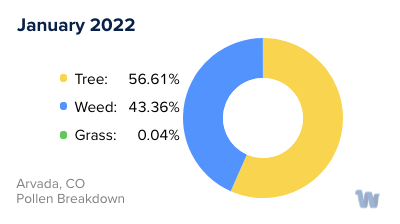
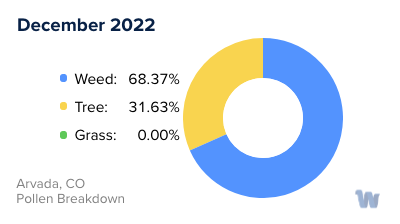



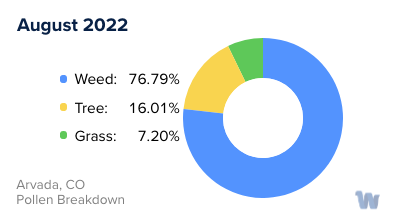
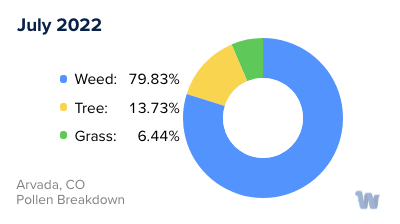
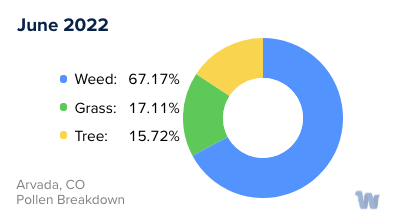

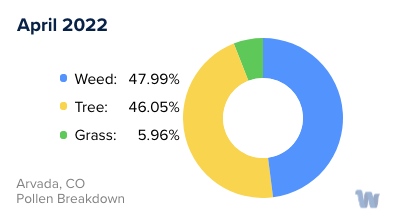


Pollen and Hay Fever in Arvada, CO
Pollen allergies and hay fever are common health concerns for many people living in or visiting Arvada, Colorado. As one navigates through the changing seasons, it's important to understand the various types of pollen present in the area and the times of year they are most prevalent.
The main culprits of pollen allergies in Arvada are tree, grass, and ragweed pollen. Each of these has a unique seasonal cycle, which contributes to the timing and severity of hay fever symptoms for individuals in the city.
Tree pollen is most common during the spring, with the season usually starting at the end of February due to Colorado's cold winters. Common tree allergens in the area include the Elm, Cottonwood, Aspen, Juniper, Cedar, Oak, and Maple trees. As the snow begins to melt and trees start to bud, pollen levels rise, often reaching their peak in April, May, and June.
As the warmer summer months arrive, grass pollen takes over as the primary allergen. This is the time when green spaces in and around Arvada come alive, but it also means that those sensitive to grass pollen might experience a rise in allergy symptoms.
As summer transitions into fall, ragweed pollen becomes more prevalent. Although ragweed is not as common as tree or grass pollen in Arvada, it can still contribute to seasonal allergies during this time.
The allergy season typically ends with the first winter freeze, providing a much-needed break for allergy sufferers. However, it's important to note that while outdoor allergens may decrease during the cold winters, indoor allergens can still cause issues.
In conclusion, understanding the types of pollen and their seasonal cycles in Arvada, Colorado can be immensely helpful for those prone to allergies. It enables individuals to anticipate potential flare-ups of hay fever symptoms and adjust their routines accordingly, thus improving their quality of life throughout the year.


